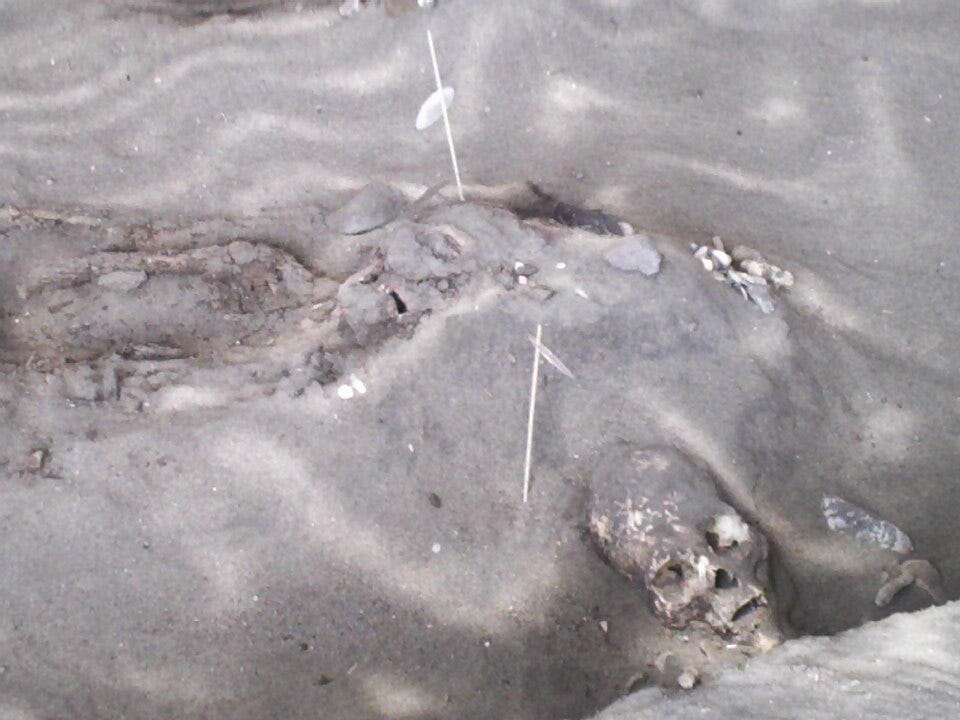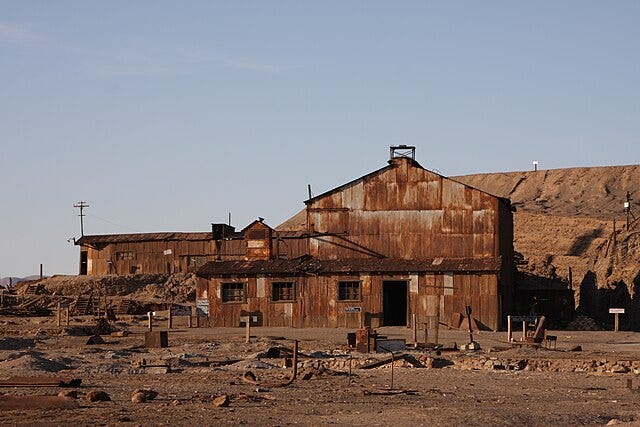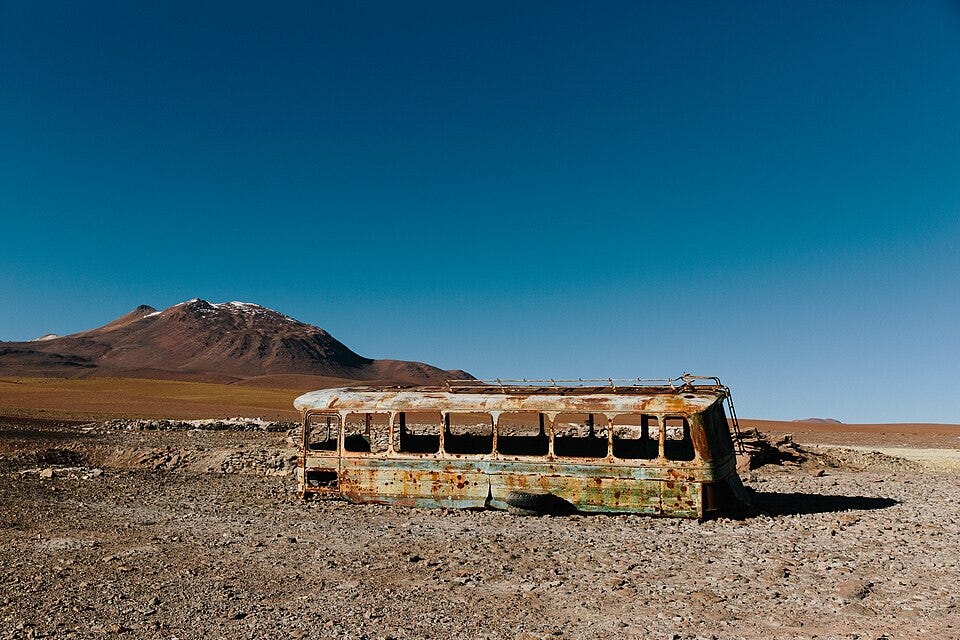
By the time you read this, I will have just arrived in Santiago, Chile - barring any mishaps - on my way to spend the next six weeks in and around the Atacama desert of northern Chile. It’s a trip that I’ve been planning ever since I got back from Patagonia in the spring of 2023, and because it will temporarily change the way I write this newsletter, it’s a journey that needs some explaining.
Until recently, I never had any particular desire to visit a desert, but I do have an extensive repository of literary and cinematic desert memories that reaches all the way back to my childhood readings of Tintin comics, Beau Geste, and films like Tobruk, The Flight of the Phoenix and Laurence of Arabia. And let’s not forget the Bible - another early introduction to my literary desert, from the Israelites’ trek through the Sinai to Jesus’s 40-day fast.
All these youthful readings reinforced a very specific idea of the desert in my adolescent mind - a peripheral, borderline space of emptiness, desolation and solitude that was best avoided, where humans survived only by resilience, luck or divine guidance. And yet also a place where prophets and holy men retreated in order to meditate, fast and test their ability to resist temptation.
Years later, I watched Luis Buñuel’s sarky take on Christian asceticism Simon of the Desert. I laughed - who wouldn’t? - at the final scene when the hermit Simon gapes at a jet plane, which transports him from his desert pillar to a Mexican beat club, watching Satan (played by the director’s wife Sylvia Pinal) cavorting to surfing guitar music. I also lapped up books like The Seven Pillars of Wisdom, The Sheltering Sky, Edward Abbey’s Desert Solitaire, and Sven Lindqvist’s Desert Divers. I was entranced by the desert landscapes in Antonioni’s Zabriskie Point and The Passenger, and repelled by Bertolucci’s Moroccan-holiday-from-hell version of The Sheltering Sky.
I understood that deserts were places where people - well mostly western people - went to find themselves, and sometimes ended up losing themselves. Others merely crumbled away - reduced to nothingness like the ruined statue in Shelley’s Ozymandias, where: ‘Round the decay/Of that colossal Wreck, boundless and bare/The lone and level sands stretch far away.’
As interesting as deserts were from a poetic and philosophical point of view, I had no particular desire to follow the footsteps of these literary or real ‘desert divers’. I was content to see deserts in passing, while travelling from one place to another, whether it was a three-day bus trip from Quetta to Iran through Baluchistan, a glimpse of the distant Sahara while getting lost in the Atlas Mountains, or seeking out migrant encampments in northeastern Morocco near the Algerian border. Once, a Moroccan NGO offered to help me cross the Sahara Desert from Algeria to Niger disguised as a missionary - an offer I wisely turned down, because really, the chances of my survival were slim at best.
And yet here I am, at the age of 69, about to spend six weeks in the driest desert on earth. This unlikely expedition can be traced back directly to my journey through Patagonia to research Darwin’s Savages. In researching that book, I developed a fascination for these supposedly peripheral and ‘empty’ South American spaces that had played such a decisive role, not only in the histories of the countries that enclosed them, but in the history of the wider world.
Patagonia isn’t most people’s idea of a desert: it has mountains, forests and lakes; much of it consists of semi-arid steppes covered with grazable grass and sagebrush. Its grasslands were the main reason why nineteenth-century Argentina wanted to settle the land and subjugate its people. But Argentinians called it a desert and set out to bring it into the remit of ‘civilization’ through conquest and colonisation. Explorers, scientists and soldiers paved the way for settlers, ranchers and flows of international capital, which integrated the ‘desert’ into the global economy and transformed Patagonia into a source of wealth for companies, individuals and stockholders thousands of miles away - a process which all but annihilated its Indigenous inhabitants.
I have just spent more than two years studying the contradictions between the official histories of Patagonia as the ‘end of the world’, and its unrecognised or erased histories that included ‘extinct’ Indigenous peoples; penal colonies and political concentration camps for undesirables; the ruthless exploitation of workers who made ranchers and shareholders rich; the scientists and grave robbers who looted Indigenous cemeteries.
The Atacama Desert is filled with similar contradictions. In the sixteenth century it was written off as a barren ‘despoblado’ (an uninhabited wilderness) by the Spanish soldiers who crossed it on their way from Peru to southern Chile. In fact, the Atacama has been inhabited for more than 10, 000 years by Indigenous peoples. They include the long-vanished Chinchorro people, creators of the world’s oldest artificial mummies:
Like Patagonia, the Atacama has often been described as a peripheral zone, even though it has played a vital role in Chilean and world history. This is a desert where the course of World War I was once decided by a naval battle in 1914, which cut off the flow of Chilean nitrates from the Atacama to Germany and paved the way for a global agricultural revolution. Where British ‘nitrate kings’ played cricket and polo while striking workers were massacred by the Chilean army. Today, the ruins of nitrate kingdoms litter the desert - rusting testaments to 20th century cycles of boom and bust:
The nitrate trade transformed the Atacama into the casus belli and the primary battleground of one of Latin America’s first resource wars - the 1879-1884 War of the Pacific between Chile and a Peruvian-Bolivian alliance. The Allende government was overthrown in 1973, in part, because of its determination to nationalise the copper industry, much of which is located in the Atacama.
As a young army officer, Augusto Pinochet did his military service in the desert. Many years later, between September 30 and October 22, 1973, a military death squad operating under his orders murdered Socialist Party members across the Atacama and dumped their bodies in the desert. Today, the 21st century’s ‘green revolution’ is driving the extraction of Chilean copper and lithium, in order to provide essential components for Iphones, electric cars, fibre-optic cables and solar panels.
And now the desert is the foremost astronomical observation point in the world, and an ‘analogue’ for the exploration of Mars. I first became aware of some of these histories in Patricio Guzmán’s poetic meditation on time, astronomy and history Nostalgia for the Light.
In a way, it was Guzmán who took me to Patagonia, and it was Patagonia that led me to follow his footsteps to the Chilean Norte Grande (the Big North). Travelling across the Patagonian steppes after two years cooped up during the pandemic, I spent many hours in a state of euphoria, mesmerised by Patagonia’s enormous, unsettled spaces, by its geological formations, its seemingly unreachable horizons and fiery sunsets. I was conscious, in a way that I never am in domesticated, overcrowded England, of the vast time scales that had shaped this utterly beguiling landscape.
If I had to identify any single moment that brought me to the Atacama, it would be the day when I visited the Cueva de las Manos (the Cave of the Hands) - a famous Indigenous landmark in the Patagonian province of Santa Cruz. That day we got up early and drove for about an hour and half from the town of Perito Moreno through the Patagonian steppe, before turning into a dirt road that led through a recently-created national park. As always, I was thrilled by the wild desolation of the Patagonian landscape, by the flocks of guanaco and flightless Rhea birds, the imposing slabs of bare rock, and the sense of endless space.
I remember in the mid-morning, we walked down into a canyon towards the caves, and beyond the glittering walls of igneous rock, I saw a vast plain, scattered with mountains and sheered-off plateaus that seemed entirely untouched by anything human. In that moment, it was possible to imagine that nothing in this landscap had changed in millions of years. I was conscious of my smallness, and of the paltriness of my own human lifespan. I didn’t feel crushed by this awareness; on the contrary, I felt strangely reassured by the thought of all those millions of years that had preceded me.
In his 1956 essay On How to Grow Old, Bertrand Russell once gave the following wise advice to those suffering from the fear of death:
The best way to overcome it—so at least it seems to me—is to make your interests gradually wider and more impersonal, until bit by bit the walls of the ego recede, and your life becomes increasingly merged in the universal life. An individual human existence should be like a river: small at first, narrowly contained within its banks, and rushing passionately past rocks and over waterfalls. Gradually the river grows wider, the banks recede, the waters flow more quietly, and in the end, without any visible break, they become merged in the sea, and painlessly lose their individual being.
That morning at the Cueva de las Manos, I felt that sense of abandonment. Looking out beyond the canyon towards a world that was so much older than anything I could even imagine, I understand what the poet Mary Oliver meant, when she wrote of her desire to ‘be the tiniest nail in the house of the universe, tiny but useful. May I stay forever in the stream.’
That morning, I felt connected to the stream - a privileged observer of the physical evidence of geological Deep Time. And later that day, I thought of Guzmán’s film, and I thought I might try and get to the Atacama. That desire has only grown stronger since my return to England. In December 2023, my mother passed away, and two of my oldest friends also died within six months of each other. My mother was ninety, but my friends were the same age as me. I had known both of them since my teens, and there was no more reason why they should be dead than there was why I should still be walking.
Events like these inevitably remind you that time is limited; that whatever your individual life may or may not amount to, you are subject to the laws of biology and the random twists of medical fate and the vagaries of your own particular metabolism. There was a time when I thought of death like the opening shot of Omar Sharif in Lawrence of Arabia - a tiny dot coming out of the desert towards the oasis where I happened to be drinking. But now he was coming closer - too close to be ignored. And this proximity has intensified my own ‘nostalgia for the light’ and a desire to see, experience - and write about - the desert that I first saw in Guzmán’s haunting masterpiece.
So for the next few weeks, I will be posting ‘letters from the desert’ about the Atacama and related matters. This will not be a travel journal as such. I won’t be telling you what I ate, where I stayed, or how I got from one place to another.
Expect a few more pieces than usual, on a range of subjects that include politics and history, and also some more personal and philosophical reflections on time, death and mortality, on the antihuman dimensions of billionaire space travel and billionaire transhumanism. Expect soldiers and ‘nitrate kings’; ghost towns, mummies and miners; the environmental consequences of copper mining, lithium production, and toxic metal and fast fashion dumping. I will be writing about forgotten concentration camps and the search for the Chilean ‘disappeared,’ and I will also be writing about Indigenous astronomy, Kurt Waldheim’s Voyager, and the politics of Mars exploration.
I also intend to explore some more overlooked dimensions of the Atacama, and of deserts in particular: the people who love the Atacama and have learned to live in it; the unexpected life contained in the desert, and the ‘solace of fierce landscapes’ that I also experienced in Patagonia. All these elements will be part of my journey to the far north, and I hope you will come with me, so that I can tell you what I saw and what I found, and what I felt about it.
I hope I can convince you, in this deep dive into the politics, geology, culture and history of the Atacama, that deserts are not always what we think they are, and that this particular desert is so much closer to the world than many of us realise.






I visited the Atacama briefly in 2008. Long to return -- if only vicariously through your interesting journals. A desert is land stripped of much of the clutter of human existence, where we are just poor, bare, forked animals ... unaccommodated man.
Im very envious. Some of our favourite places have been deserts - top of the Sahara, driving across Iran and Afghanistan, Namibia, walking and sleeping out around Wadi Rum (and of course reading Seven Pillars). They all have histories and are not as empty as they might seem.
Looking forward very much to the missives.